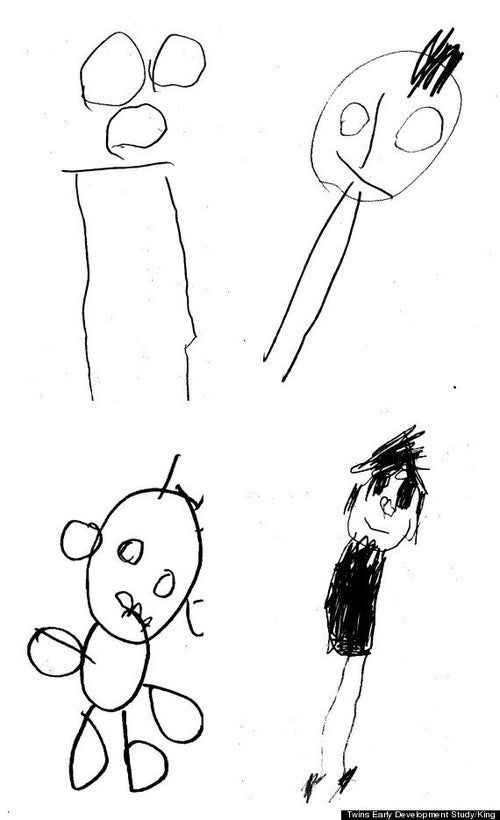In a far away drawer in most parents' houses lies a tea towel with a child's self-portrait on.
There's no denying these primary school keepsakes are adorable, but did you know the Mr-Blobby-style scribbles could also reveal something about a child's intelligence?
A four-year-old's people-drawing ability provides an indicator of his or her intelligence at age 14, scientists have found.


Parents might laugh at their child's quaint crayon scribbles, but the balloon heads and stick-like limbs have a serious hidden meaning, research shows.
They reveal a connection with gene-driven intelligence that has a measurable effect 10 years later.
With the help of parents, psychologists got 15,504 children aged four to take part in a "draw-a-child" test, rating each picture with a score of zero to 12.
A "moderate" association was seen between higher scores and intelligence test results both at the age of four and 14.
Lead scientist Dr Rosalind Arden, from the Medical Research Council Social, Genetic and Developmental Psychiatry Centre at the Institute of Psychiatry, King's College London, said: "The Draw-a-Child test was devised in the 1920s to assess children's intelligence, so the fact that the test correlated with intelligence at age four was expected. What surprised us was that it correlated with intelligence a decade later.
"The correlation is moderate, so our findings are interesting, but it does not mean that parents should worry if their child draws badly.
"Drawing ability does not determine intelligence, there are countless factors, both genetic and environmental, which affect intelligence in later life."
Drawings were judged on the presence and correct quantity of features such as the head, eyes, nose, mouth, ears, hair, body and arms.
A point was awarded for each correctly presented feature. For example, a drawing of a figure with two legs rather than four or none would receive one point for legs. Any clothing indicated also scored a point.
The scoring system ignored features such as overall size, proportion, "charm" and "expressed emotion".
Drawings varied greatly between the children, ranging from disorganised scribbles that scored zero, to pictures depicting recognisable faces, bodies and limbs worth 10 points.
Because the children were divided into pairs of identical and non-identical twins, the scientists were able to look at the influence of genes on drawing ability and intelligence.
While identical twins mirror all of each other's genes, non-identical twins only share about half. However, each pair will have a similar upbringing and family background. This allows researchers to tease out traits that are mostly driven by genes or the environment.
SEE ALSO:
Is Our Children's Mental Health Worse Than Ours? If So - Why?
Hilariously Inappropriate Spelling Mistakes From Innocent Kids
This Video Of A Mother Trying To Put Her Kids To Bed Sums Up The Challenge of Having Twins
Overall the drawings of four-year-olds from identical twin pairs were more alike than those from non-identical twin pairs.
The scientists concluded that genetics was an important factor behind differences in children's drawings, and this was reflected in intelligence test scores at age 14.
The findings appear in the journal Psychological Science.
Dr Arden stressed: "This does not mean that there is a drawing gene - a child's ability to draw stems from many other abilities, such as observing, holding a pencil etc. We are a long way off understanding how genes influence all these different types of behaviour."
She added: "Drawing is an ancient behaviour, dating back beyond 15,000 years ago. Through drawing, we are attempting to show someone else what's in our mind.
"This capacity to reproduce figures is a uniquely human ability and a sign of cognitive ability, in a similar way to writing, which transformed the human species' ability to store information, and build a civilisation."
In their paper, the scientists said it was not known whether children who did well in the drawing test were likely to develop a sustained interest in art.
They wrote: "This study does not explain artistic talent; the scores only quantify accuracy of attributes, such as the number of limbs, in the drawing.
"But our results do show that whatever conflicting theories adults have about the value of verisimilitude in early figure drawing, children who express it to a greater extent are somewhat brighter than those who do not."